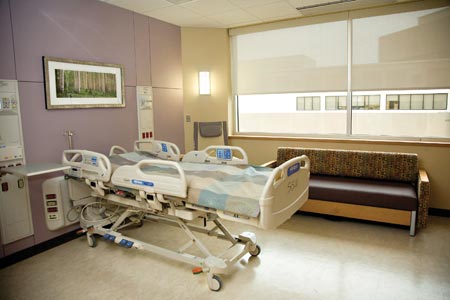By Susan Middaugh
Nurses offer ideas on room design for hospital’s new inpatient addition
Interior design requires a different skill set from providing bedside care. Nurses aren’t trained to read blueprints or to work with architects and electricians. And yet, the nursing staff at the Johns Hopkins Medicine-affiliated Howard County General Hospital (HCGH) played an important role in planning the hospital’s new 90-bed inpatient pavilion, which opened August 3.
 The collaboration made sense for several reasons. Patient safety and improved quality of care were the driving forces behind the new addition. Nurses are in daily contact with the clinical needs and wishes of patients and their families. They know what works in a hospital setting and how small changes, such as the placement of a chair, or significant ones, like having private rooms, could work better for patients and staff.
The collaboration made sense for several reasons. Patient safety and improved quality of care were the driving forces behind the new addition. Nurses are in daily contact with the clinical needs and wishes of patients and their families. They know what works in a hospital setting and how small changes, such as the placement of a chair, or significant ones, like having private rooms, could work better for patients and staff.
Doree Turnage, RN, PCCN, clinical program manager for the new 3 Pavilion, participated in a committee of nurses that met regularly to offer ideas and feedback on room design to Beth Plavner, HCGH’s special projects administrator who was in charge of overall planning for the new four-story pavilion. “Safety was a first concern,” said Turnage, whose unit cares for a wide variety of illnesses from stable ventilator patients to those in need of pulmonary, renal, and surgical care. Many of these patients are elderly. One outcome of these planning meetings: bathrooms in the new pavilion feature elevated commodes with side railings for ease of use. To decrease the risk of falls, safety railings were installed at strategic locations to assist patients in getting to the bathroom safely.
The nurses also wanted to make sure there was adequate clearance for their carts and equipment to navigate the hallways and patients’ rooms. “Beth constructed a mockup room so that the staff could offer their concerns and opinions,” said Turnage. “We also wanted enough space to accommodate family members who are visiting or spending the night. Having a family member present is very reassuring to an elderly patient. As a result, each inpatient room has a sleep sofa, a desk large enough for a laptop, shelving for personal items, and a closet.”
The new addition contains three new 30-bed inpatient units, all with private rooms. Private rooms reflect a trend in hospital design since the introduction of HIPAA, the federal privacy law, Turnage explained. This trend also helps reduce patient infection because it lowers the risk of cross-contamination that could occur from having a roommate.
Reducing medication errors was also a priority for the hospital. One solution the nurses came up with was to keep each patient’s medications in an alcove outside his or her room. Each alcove in the new pavilion contains a place for the nurse to sit at a computer to take notes and monitor the patient’s heart rhythms on a telemetry screen. This arrangement is “nurse friendly,” said Jacqueline O’Neale, RN, a staff nurse on 2 Pavilion, who participated in a feedback session on the prototype room design. O’Neale and her colleagues suggested that each alcove house a locked drawer for each patient’s medications and a cabinet above the desk be set aside for storing supplies such as tissues, bedpans and urinals.
“All the nurses like the new room design and the alcoves,” said O’Neale. “We can sit at the desk and do our work. We don’t have to be at the nurses’ station.”
“The patients like it too,” said Turnage. “Each room has calming colors, a large window, and artwork hanging above each bed. The rooms are light-filled, clean, and quiet, which is more restful for the patients and consequently less stressful for the staff.” One patient recently commented that she had donated to the hospital and it was very nice to see her donation go to such good use, Turnage said.
